
Analyzing needs.
Reinventing technology.
Simplifying solutions.
Light Section Sensors with SmartRunner Technology
Benefits

Commissioning via Plug&Play

Flexibility in Production Adjustments

Convenient and Quick Assembly
In Combination, an Innovation
SmartRunner technology is a unique combination of light section technology and a 2-D vision sensor with integrated LEDs. The result is ready-to-use, plug & play light section sensors that offer a variety of technical features.
The proven light section technology is based on the triangulation principle and allows versatile detection tasks, such as precise detection of height profiles and edge lines. Light section sensors are highly precise, insensitive to extraneous light, and function independently of target objects’ color and surface texture. The integrated camera function, including LED lighting, streamlines parameterization with Data Matrix control codes. Additionally, recording of error images is possible, allowing personnel to intervene quickly and efficiently in case of disruptions.
The new light section sensors are optimized for specific tasks. Get to know the first representatives of the new SmartRunner product family.
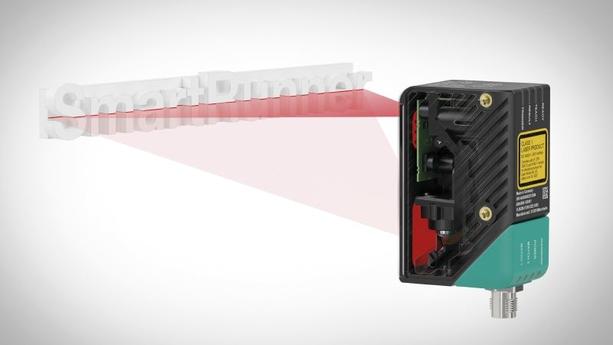
Ready to Use—Application-Specific Sensors for Efficient Processes
The SmartRunner technology offers completely new applications for demanding detection tasks and allows you to design efficient, future-proof processes. Get to know the first representatives of the new SmartRunner product family: the SmartRunner Detector and the SmartRunner Matcher.
SmartRunner Matcher—
The Specialist for Profile Matching
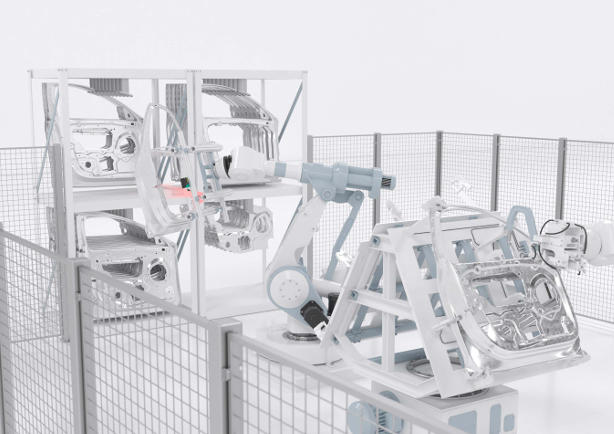
A typical application for the SmartRunner Matcher is car body construction in the automotive industry. Here, different car body parts must be precisely aligned before they are grasped, positioned, and welded by industrial robots. To check the correct alignment of the components, two SmartRunner Matchers each are aligned to one edge of car body panels.
The height profile detected is saved via teach-in and used as a reference contour for profile comparison. Only if the correct component has been positioned within the adjustable tolerance, both sensors output a corresponding switching signal, allowing the robot to grasp the object unimpeded. Using the Matcher avoids unplanned downtimes and damage to expensive car bodies and robots.

Commissioning the Matcher is simple: the sensor just has to be mounted and aligned to the desired profile and then programmed using the teach-in—the reference contour is programmed and the machine process can begin. Since the application-specific evaluation is integrated directly into the sensor, easy-to-process digital signals are produced instead of raw data. Thus, the sensor can be directly connected to the control system without much effort.
Quick responses to changing car body types and quantities of packaging are no challenge to the Matcher: the sensor can easily be reparameterized via teach-in or Data Matrix control codes. Even different object surfaces or colors are quickly implemented due to the split-beam procedure.
How Does It Work?
Here, you can see how the Matcher compares object contour, position, and distance based on the adjustable tolerance:
"Good" Signal Scenario 1: the Matcher recognizes the previously taught-in reference contour. The gripping process starts.
"Good" Signal Scenario 2: the Matcher detects a slight deviation that is still within tolerance range. The gripping process starts.
"Bad" Signal Scenario 3: the deviation is outside the tolerance rage. The gripping process stops.
"Bad" Signal Scenario 4: too long distance between sensor and object. The robot has to be moved before the gripping process can be initiated.
"Bad" Signal Scenario 5: detection of an incorrect or defective object. The gripping process stops.
More Use Cases for SmartRunner Matcher
Ensuring Reliability in Ready-Meal Production
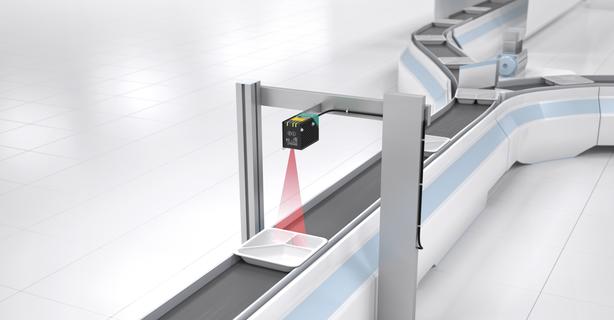
Plastic trays divided into several small compartments are often used when producing ready meals in the food industry. Filling the individual compartments in the plastic tray and carefully separating the different meal components is an essential prerequisite for acceptance by the customer and for properly sealing the container. In the case of a defect, the product cannot be sold, and the meal must be discarded. Checking that the plastic trays are in the correct position requires a reliable, quick, and easy-to-install solution that supports a quick and efficient filling process. The SmartRunner Matcher offers the ideal solution for checking the position of the plastic trays.
Smooth Material Feed in Production Plants

An uninterrupted supply of raw materials is crucial for maintaining cost-effective operations in production plants. The materials, which can vary in color, are transported to the machine in workpiece carriers. Before the materials are picked up by the robotic system, it is necessary to check whether the materials are present (presence check) and whether the materials are in the correct position (position control). Efficient operation without plant downtime or production waste is always the top priority. With the SmartRunner Matcher light section sensor, both detection tasks can be performed in a single step.
SmartRunner Detector—
The Specialist for Area Monitoring
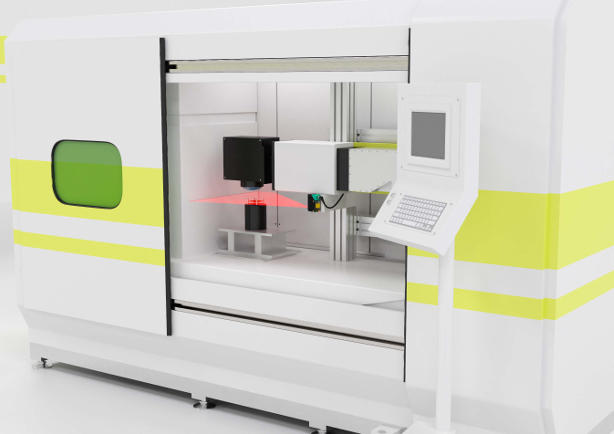
This laser machine is used to calibrate the switching distance of sensors. For different sensor models, various clamping tools are needed. When the program is activated, the laser moves to the appropriate height, and the calibration process begins. If the device used is too high, protruding objects can damage the expensive laser lens.
To prevent this, the Detector is mounted below the laser and extends its detection field. If a faulty object enters the monitoring field, the sensor supplies a switching signal and the stop is triggered before the lens can be damaged. This way, the Detector protects expensive components and increases machine availability at the same time.

Commissioning the Detector is extremely easy through the factory-worked optimization for highly accurate monitoring: the user installs the laser line on a wall—like in this specific application example—or another fixed background and easily programs this through Teach-In. No PC is required and exposure times do not have to be adjusted manually.
If only specific application-related areas need to be monitored, you can freely define so-called Regions of Interest (ROI). Objects that occur in the detection zone outside of the ROI are detected but no switching signal is produced. The definition of minimum or maximum sizes of the objects avoids false alarms by external factors.
How Does It Work?
Here, you can see how the Detecter works by monitoring background and detecting objects.
"Good" Signal Scenario 1: no object interferes with the laser line. Machine operation proceeds as planned.
"Bad" Signal Scenario 1: the Detector recognizes an object interfering with the laser line. A switching signal causes machine operation to stop.
"Bad" Signal Scenario 2: a hard to detect object with a mirroring surface interferes with the laser line. Since the detector evaluates both the laser line on the object as well as on the background, the detection results are always plausible. Therefore, a broken background line is shown on the malfunctioning object in the detection area, so that the sensor responds immediately. This parallel evaluation ensures completely reliable processes for the user.
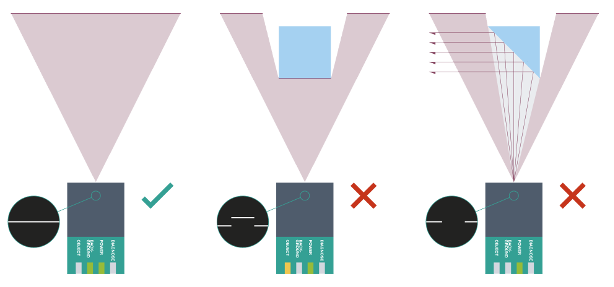
Contact Us
Do you have any questions on the SmartRunner product family, or do you want to receive more information? We are happy to help! Simply fill out the contact form and send us a message.


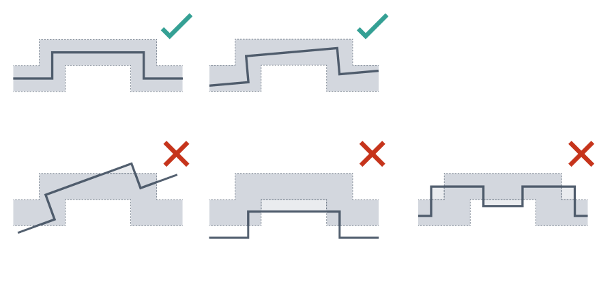
 Further Information
Further Information

 +49 621 776-0
+49 621 776-0